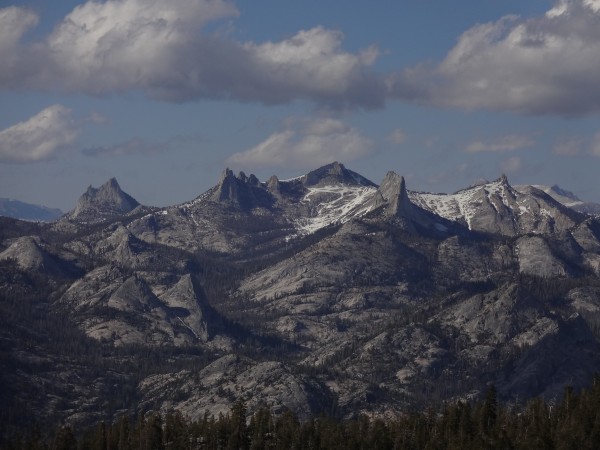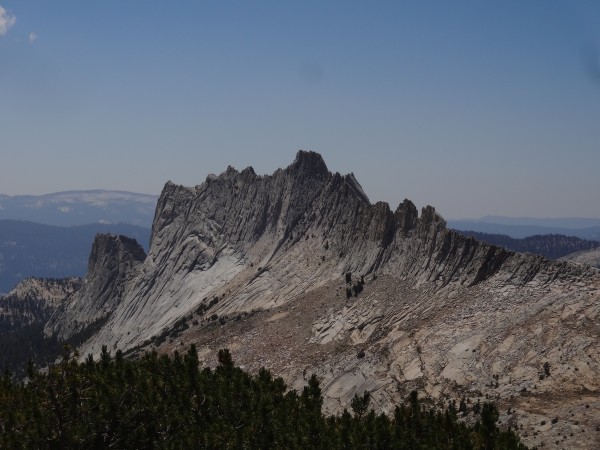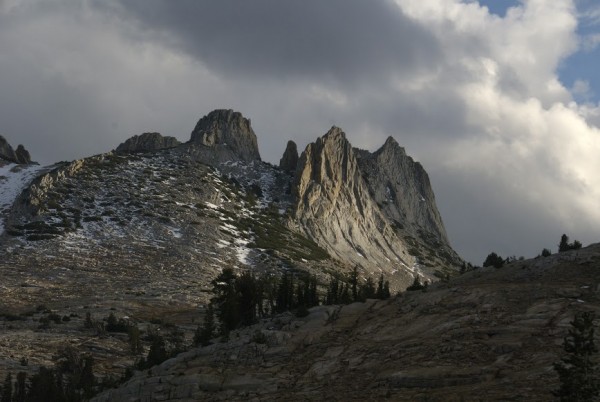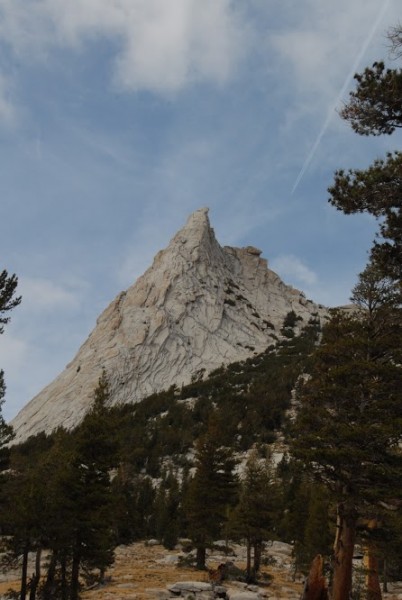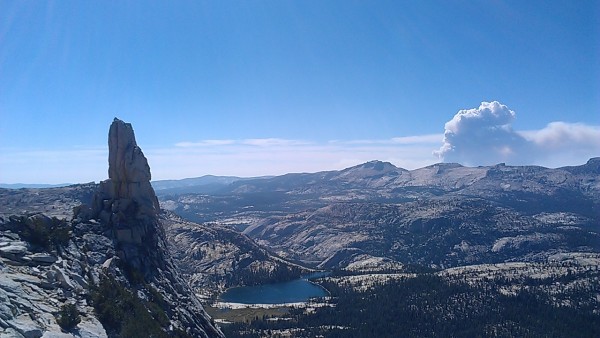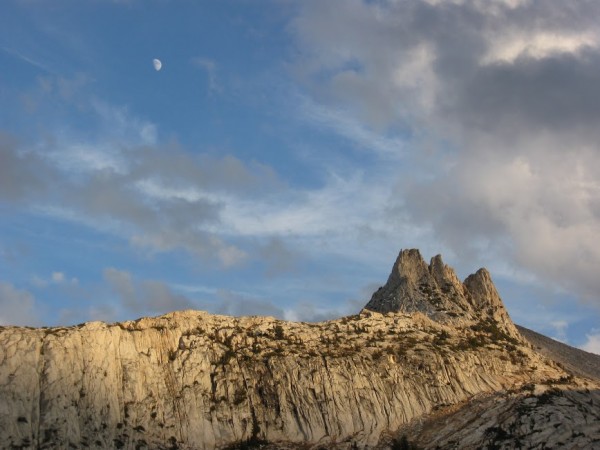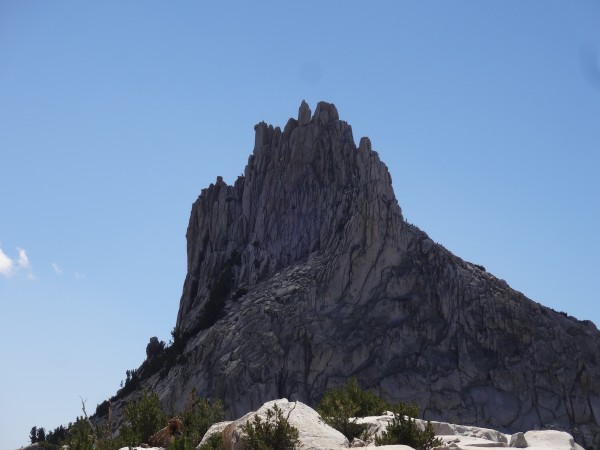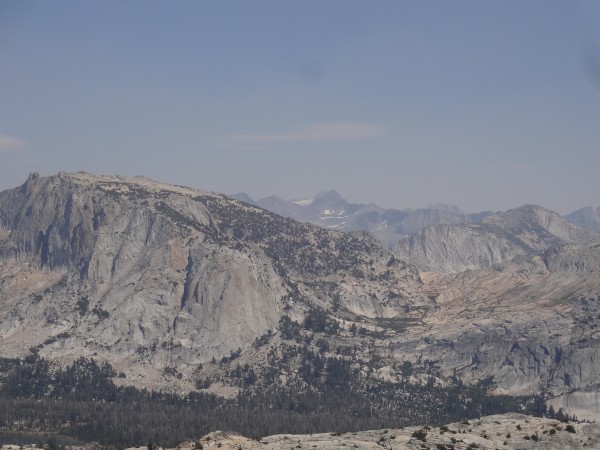Tenaya
Tresidder
Columbia Finger
Matthes Crest (S to N)
Echo Ridge
Echo Peaks #1 through #9
Cathedral
Eichorn
Unicorn
Cockscomb
I call this 'the fun part', and it took just under 12 hours. I carried a sleeping bag and headed toward Johnson peak, where I dropped for the night. On Sunday I added:
Johnson
Rafferty
Fletcher
Vogelsgang
I had only my cell phone camera, so many of the pictures in this report were accumulated from other trips.
I had decided to do a big link-up in this area after running a stripped-down version of the Cathedral traverse last summer. On that trip, I hit Cathedral, Matthes, the 9 Echo peaks, Echo Ridge, Cockscomb, and Unicorn. I carried a thin rope so that I could rappel from the North Summit of Matthes and from the top of #9. This was, all around, a beautiful day. While I spend most of my high-sierra time in the Palisades, I often leave that range feeling like a broken version of myself. Tuolumne is a kind and gentle place; a high density of solid, aesthetic peaks that can be connected by running through open meadows and over granite slabs.
Earlier this year, I had been looking at a map of Yosemite when I noticed the words "CATHEDRAL RANGE" sprawling all the way from Tenaya down to... Lyell?? This was great and unexpected news. I had mistakenly thought that Lyell was part of the Clark range. While I had considered linking up these mountains with those surrounding Cathedral peak, now there was an even more cohesive reason to do so: a link-up of the full Cathedral range. The distance from Tenaya to Lyell is daunting, so I decided to keep expectations low. I would carry a sleeping bag and continue climbing peaks southeast of Cockscomb until I stopped having fun. As it turned out, this happened around Vogelsgang.
I also decided that this trip would be quite a bit faster and more fun without a rope. While I was looking forward to unweighted running, this added 3 cruxes (the downclimbs from Matthes, #9, and Eichorn) that made this a significant upgrade in difficulty from my previous link-up. Downclimbing, I feel, is a near crime against nature--if the gods had meant for me to downclimb anything, they would have placed eyes in my ankles. I take no pride in downclimbing and would just as soon rap from any given peak if I were willing to carry the rope. To prepare, I spent my Friday in meditation.
Where, by 'meditation', I mean that I sat next to Tenaya lake, drinking whiskey and listening to Les Claypool.
I started toward Tenaya peak at 5:45 a.m. on Saturday morning. Tenaya took a bit longer than expected, just over an hour to the summit. From here, it's an easy jog to the summits of Tresidder (where I opted to not take the entire ridgeline in the interest of time) and Columbia Finger. On my way to Matthes I stopped by Echo Lake to fill up water. I started on Matthes somewhere between 9 and 9:30 a.m., passing one party on the first pitch. It took me about 45 minutes to reach the north summit, where I put on my climbing shoes for the first time that day. DiFranco's 'I am not a pretty girl' played through my ipod as I was starting the series of crux-y downclimbing sections. I sang along, realizing that downsoloing the crux on Matthes Crest may be the one opportunity of my life to belt out a rendition of this song free from any kind of judgement. The second best thing about soloing is that no one is around to hear you sing. This section of Matthes felt soft for 5.8.
From the north end of Matthes, it is a sandy climb up to the southeast corner of the Echo Ridge summit, which I descended via granite slabs to the northwest. I jogged up Echo Peak #8 before heading to #9. #9 is both fun and the most difficult peak in the Cathedral Range (though an argument can be made for Matthes), so I am surprised at how rarely it is climbed. The routefinding can be confusing, so here it is: Starting at the southwest corner, head up and right via a low angle gully that turns left and steepens. The lowest-angle route becomes slick and loose, so I tend right onto vertical granite that is covered in quarter-sized knobs. Follow these knobs to a large horizontal crack under an overhanging wall. Take this crack left, where it turns into a ledge. At the corner near the west face, an easy move can be pulled over the roof. From here, head up to a large ledge and move right. On a smaller ledge, reach high and right over blank face to a flake/jug and pull. From here, move up and left to flat ground. The route from here is straightforward: a wonderful, 20-foot, vertical handcrack and a knob-covered bulge to the summit.
The downclimb from #9 was the crux of the trip. While the downclimb on Matthes might be just as technically challenging, each section is only two or three moves. #9, on the other hand, is pretty consistent the whole way down. As one that tends toward crack climbing (and, while we're listing my preferences, climbing in the upward-direction), I will admit that I do not like that last 100 feet down vertical face on tiny knobs. Luckily, this section is more solid than I expected and I was happy that only two knobs snapped off under body weight. The rest of the Echo peaks went down in the order #7, 5, 6, 1, 2, 3, and 4. It took maybe an hour total for #1-#8.
I jogged over to Cathedral and started climbing at about 2 p.m. I had been dreading the climb up Cathedral on a Saturday afternoon, but everyone on the route was remarkably gracious in dealing with me being in their way as I passed through. Cathedral, as always, was a wonderful climb.
The climb up Eichorn is straightforward but fairly exposed. I'm not one to expend energy thinking of the fall, but it is bound to cross the mind of everyone that spends any amount of time with nothing under their shoes but hundreds of feet of empty air. I thought of it once somewhere near the Palisade crest, where I am certain that it would be a dark and violent affair.
I am sure that this can not be the case in Tuolumne. I am sure that, when she fell, moments turned to hours. That her body was welcomed by the meadows; that her final breath gently dispensed her consciousness so that it now circulates in the air surrounding the Cathedral Range. It is there for the tired climber and the blister-covered tourist; it is inspired and courses through our veins, adding a measure of passion and boldness to the time that we spend here.
At least, that is how I like to think of it. I gave my wishes to the shade that resides on that summit and began my downclimb. I had to pass a party that was starting up the route and, once again, was grateful in how kind they were in pausing their ascent so that I could pass through without tangling myself up in their ropes.
When I finished Eichorn, I had been climbing for just over nine hours. My energy level dropped a bit and I moved more slowly down to Budd lake for water, up to Unicorn, then back to summit Cockscomb at 5:40 p.m. The section of the traverse from Tenaya to Cockscomb took just under 12 hours at what felt like a slow and steady pace.
From here, I walked east and slept at the lake immediately southwest of Johnson. In the morning, I woke up and climbed Johnson, took the highest-elevation line over to Rafferty, dropped into the valley near the Vogelsgang high Sierra camp, and tagged Fletcher and Vogelsgang. These peaks were considerably easier, larger, and more spread out than the work of the previous day. I was getting tired, and the growing miles of talus-hopping between mountains was making the trip less fun as time went on. I decided to jog toward civilization, making it out in time to grab a cold beer from the Tuolumne store.
I would consider a link-up of the full Cathedral range to consist of the 29 named peaks, of which I climbed 22. I am happy with this number, but distance-wise, I think I was only slightly over halfway to Lyell. The remaining peaks (please correct me if I am missing something) would be Parsons, Simmons, Florence, Maclure, Lyell, Amelia Earhart, and Potter Point. I might be able to do this in three days, but it would be a slog. I don't consider myself to be considerably fit, so I'm sure that there are climbers out there that can go light and fast and finish the range in 48 hours (which is about my cutoff for calling something 'fun'). I hope that someone decides to make it happen.
